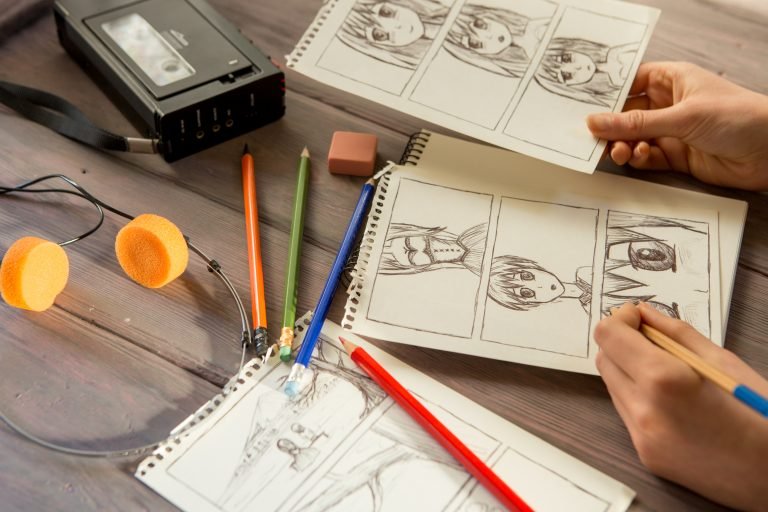The comic book industry is filled with artists whose distinct styles have shaped iconic characters and stories. These styles not only bring characters to life but also create memorable worlds that captivate readers. Here’s a closer look at the artistic approaches that define some of the most famous comic book artists.
1. Jack Kirby: The King of Dynamic Action
Known as the “King of Comics,” Jack Kirby revolutionized the art of storytelling with his bold, energetic style.
- Signature Style:
- Explosive action sequences with exaggerated poses.
- The iconic “Kirby Krackle,” a visual effect depicting energy fields.
- Notable Works:
- Co-creating Marvel’s Avengers, X-Men, and Fantastic Four.
- His work on New Gods for DC Comics.
- Impact: Kirby’s style defined superhero action for generations, emphasizing power and movement.
2. Frank Miller: The Master of Noir
Frank Miller’s dark, gritty approach transformed how comics depict urban landscapes and anti-heroes.
- Signature Style:
- Stark contrasts between light and shadow.
- Minimalist linework with intense emotional expressions.
- Notable Works:
- The Dark Knight Returns
- Sin City
- Impact: His noir aesthetic brought a cinematic quality to comics, influencing countless artists.
3. Jim Lee: The Realist Innovator
Jim Lee’s hyper-detailed, realistic style has become synonymous with modern superhero comics.
- Signature Style:
- Intricate anatomy and dynamic panel layouts.
- Clean, precise lines and vivid color palettes.
- Notable Works:
- X-Men (1990s)
- Batman: Hush
- Impact: Lee’s realism set a new standard for superhero art, blending classic and modern techniques.

4. Steve Ditko: The Visionary of the Strange
Steve Ditko’s surreal and intricate designs brought a unique flair to comics, particularly in mystical realms.
- Signature Style:
- Angular characters with fluid, dynamic poses.
- Highly detailed, otherworldly backgrounds.
- Notable Works:
- Co-creating Spider-Man and Doctor Strange.
- Impact: Ditko’s art expanded the visual language of comics, particularly in portraying the bizarre and supernatural.
5. Alex Ross: The Painter of Heroes
Alex Ross’s realistic, painted illustrations give superheroes a timeless, iconic quality.
- Signature Style:
- Photorealistic depictions using watercolor and gouache.
- Emphasis on light and shadow for dramatic effect.
- Notable Works:
- Kingdom Come
- Marvels
- Impact: Ross redefined superhero art by blending realism with mythic grandeur.
6. Todd McFarlane: The Creator of Chaos
Todd McFarlane’s style brought a sense of chaos and energy to comics, redefining how characters are illustrated.
- Signature Style:
- Extreme poses and exaggerated proportions.
- Elaborate details, especially in costumes and backgrounds.
- Notable Works:
- Redesigning Spider-Man.
- Creating Spawn.
- Impact: McFarlane’s style added a sense of unpredictability and intensity, influencing modern comics.
7. John Romita Sr.: The Romantic Realist
John Romita Sr. brought emotional depth and visual clarity to his art, particularly in character interactions.
- Signature Style:
- Expressive faces with soft, clean lines.
- A focus on character-driven moments.
- Notable Works:
- Redefining Spider-Man during his run in the 1960s.
- Impact: Romita Sr.’s work gave superheroes a more human, relatable quality.
8. Will Eisner: The Storytelling Pioneer
Will Eisner’s innovative layouts and expressive characters redefined the narrative potential of comics.
- Signature Style:
- Cinematic panel designs with a focus on visual storytelling.
- Detailed cityscapes and expressive character movements.
- Notable Works:
- The Spirit
- A Contract with God
- Impact: Eisner’s work laid the foundation for modern graphic novels.
Conclusion
Each artist’s style adds a unique flavor to the world of comics, making the medium rich and diverse. From Jack Kirby’s explosive dynamism to Alex Ross’s photorealistic grandeur, these creators have shaped how we view and connect with comic book characters. Their artistic legacies continue to inspire and evolve, ensuring that the world of comics remains as vibrant as ever.











